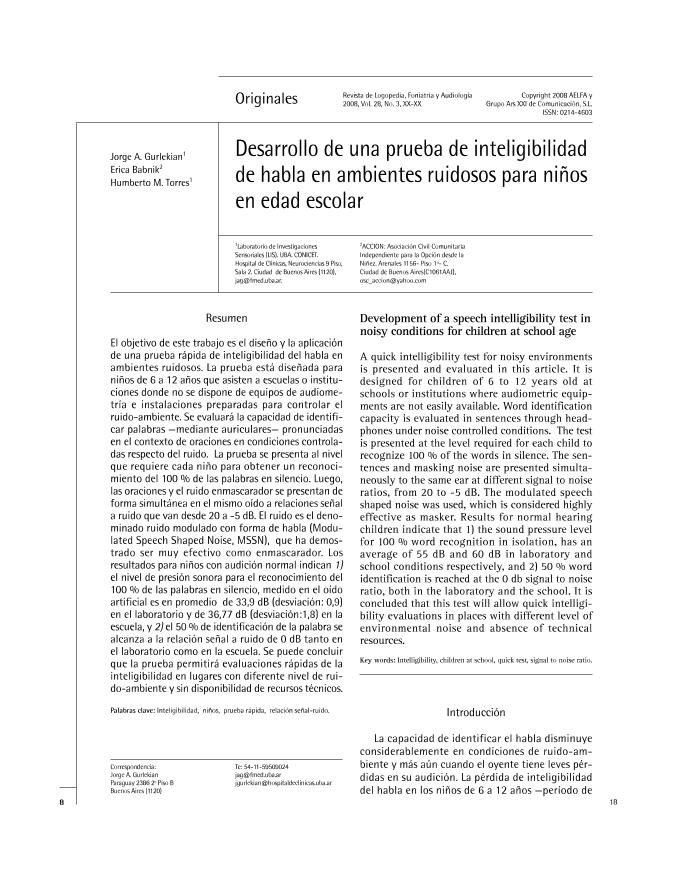Artículo
El objetivo de este trabajo es el diseño y la aplicación de una prueba rápida de inteligibilidad del habla en ambientes ruidosos. La prueba está diseñada para niños de 6 a 12 años que asisten a escuelas o instituciones donde no se dispone de equipos de audiometría e instalaciones preparadas para controlar el ruido-ambiente. Se evaluará la capacidad de identificar palabras —mediante auriculares— pronunciadas en el contexto de oraciones en condiciones controladas respecto del ruido. La prueba se presenta al nivel que requiere cada niño para obtener un reconocimiento del 100 % de las palabras en silencio. Luego, las oraciones y el ruido enmascarador se presentan de forma simultánea en el mismo oído a relaciones señal a ruido que van desde 20 a -5 dB. El ruido es el denominado ruido modulado con forma de habla (Modulated Speech Shaped Noise, MSSN), que ha demostrado ser muy efectivo como enmascarador. Los resultados para niños con audición normal indican 1) el nivel de presión sonora para el reconocimiento del 100 % de las palabras en silencio, medido en el oído artificial es en promedio de 33,9 dB (desviación: 0,9) en el laboratorio y de 36,77 dB (desviación:1,8) en la escuela, y 2) el 50 % de identificación de la palabra se alcanza a la relación señal a ruido de 0 dB tanto en el laboratorio como en la escuela. Se puede concluir que la prueba permitirá evaluaciones rápidas de la inteligibilidad en lugares con diferente nivel de ruido- ambiente y sin disponibilidad de recursos técnicos. A quick intelligibility test for noisy environments is presented and evaluated in this article. It is designed for children of 6 to 12 years old at schools or institutions where audiometric equipments are not easily available. Word identification capacity is evaluated in sentences through headphones under noise controlled conditions. The test is presented at the level required for each child to recognize 100 % of the words in silence. The sentences and masking noise are presented simultaneously to the same ear at different signal to noise ratios, from 20 to -5 dB. The modulated speech shaped noise was used, which is considered highly effective as masker. Results for normal hearing children indicate that 1) the sound pressure level for 100 % word recognition in isolation, has an average of 55 dB and 60 dB in laboratory and school conditiA quick intelligibility test for noisy environments is presented and evaluated in this article. It is designed for children of 6 to 12 years old at schools or institutions where audiometric equipments are not easily available. Word identification capacity is evaluated in sentences through headphones under noise controlled conditions. The test is presented at the level required for each child to recognize 100 % of the words in silence. The sentences and masking noise are presented simultaneously to the same ear at different signal to noise ratios, from 20 to -5 dB. The modulated speech shaped noise was used, which is considered highly effective as masker. Results for normal hearing children indicate that 1) the sound pressure level for 100 % word recognition in isolation, has an average of 55 dB and 60 dB in laboratory and school conditions respectively, and 2) 50 % word identification is reached at the 0 db signal to noise ratio, both in the laboratory and the school. It is concluded that this test will allow quick intelligibility evaluations in places with different level of environmental noise and absence of technical resources. Copyright 2008 AELFA y Grupo Ars XXI de Comunicación, S.L.vons respectively, and 2) 50 % word identification is reached at the 0 db signal to noise ratio, both in the laboratory and the school. It is concluded that this test will allow quick intelligibility evaluations in places with different level of environmental noise and absence of technical resources. Copyright 2008 AELFA y Grupo Ars XXI de Comunicación, S.L.
Desarrollo de una prueba de inteligibilidad de habla en ambientes ruidosos para niños en edad escolar
Título:
Development of a speech intelligibility test in noisy conditions for children at school age
Fecha de publicación:
07/2008
Editorial:
Ars Medica
Revista:
Revista de Logopedia, Foniatria y Audiologia
ISSN:
1578-1712
Idioma:
Español
Tipo de recurso:
Artículo publicado
Clasificación temática:
Resumen
Palabras clave:
CHILDREN AT SCHOOL
,
INTELLIGIBILITY
,
QUICK TEST
,
SIGNAL TO NOISE RATIO
Archivos asociados
Licencia
Identificadores
Colecciones
Articulos(INIGEM)
Articulos de INSTITUTO DE INMUNOLOGIA, GENETICA Y METABOLISMO
Articulos de INSTITUTO DE INMUNOLOGIA, GENETICA Y METABOLISMO
Citación
Gurlekian, Jorge Alberto; Babnik, Erica; Torres, Humberto Maximiliano; Desarrollo de una prueba de inteligibilidad de habla en ambientes ruidosos para niños en edad escolar; Ars Medica; Revista de Logopedia, Foniatria y Audiologia; 28; 3; 7-2008; 138-148
Compartir
Altmétricas




